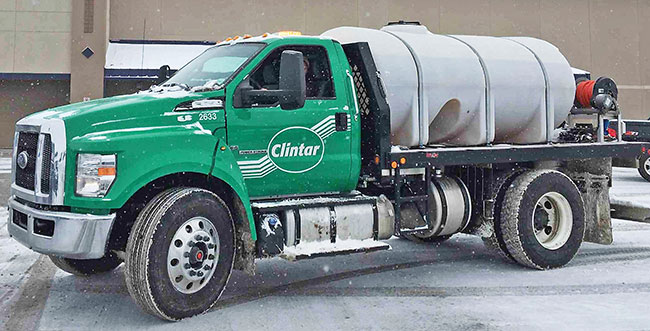
Features
Ice & Snow Equipment
Snow & Ice
Switching to brine, even if homemade, helps environment
Brine may not necessarily replace salt, but helps reduce consumption levels
March 11, 2021 By Clintar Commercial Outdoor Services
 One of the trucks in Clintar’s Calgary fleet is equipped for using brine as a de-icing material.
One of the trucks in Clintar’s Calgary fleet is equipped for using brine as a de-icing material. As one of the largest snow and ice contractors in Canada, Clintar is responsible for maintaining important commercial outdoor properties, including hospitals, distribution centres and municipal buildings throughout the year.
To better understand and reduce our environmental impact during the winter months, Clintar is studying the role liquids play as part of the solution to anti-icing operations. While liquid brine is not necessarily a replacement for road salt, it is an important piece of the solution that can help to reduce salt consumption while maintaining a high level of safety.
In our recent efforts to better understand the role of liquids, we have learned these helpful tips:
Select the right brine solution
Before the beginning of the 2020-2021 winter season, we took an inventory of the types of liquid brines that were being used across the Clintar franchise network. We found that some franchises preferred to purchase liquid brine direct from a manufacturer while other franchises chose to make their own brine. While purchasing liquid brine may save time, it comes at a much higher cost than creating your own brine.
Differences in regional climate may play a role in selecting the right brine. Since brine can come in many different concentrations and forms, it is important to understand what the right solution is for your climate. There is no “silver bullet” for choosing the right solution, however, there are guides available that help you to understand which liquid would be best in your case.
Fun Fact: To conserve water, Clintar’s Halifax franchise harvests rainwater throughout the spring, summer and fall seasons and fills a large storage tank in its shop which is used to make its own brine during the winter.
Create a plan of attack
Before the start of winter, Clintar formed a brine committee that would be responsible for applying brine throughout the winter and collecting data to be sent to the head office. The committee was comprised of four Clintar franchises from different regions. Each franchise chose two commercial sites of the same size and category. One of the chosen sites was serviced exclusively with road salt while the other site was serviced with a combination of liquid brine as a pre-treatment and road salt as a post treatment.
For each site, we collected as much relevant data as possible. Quantity of road salt and/or brine applied, air temperature, total kilometres driven to site were all important factors that we considered. The idea was that by choosing two similar sites in each region we would be able to easily compare the effectiveness and cost of each solution and share results with the other franchises to encourage the adoption of new brine programs.
Use your resources
Snow and ice contractors are fortunate to have several dedicated organizations and associations at their disposal to help drive their growth. Before we began our brine study, we encouraged our franchise owners, management staff and supervisors to complete the Fundamentals of Liquids training course offered from SIMA, the Snow and Ice Management Association.
The course provided a great foundation and introduced best practices for applying liquids. It was extremely helpful in getting franchise owners and their crews excited about applying brine and why brine is an important part of the winter anti-icing solution. We also encouraged each Clintar franchise to become Smart About Salt certified. The certification program is designed to improve winter salting practices, reduce over-application and protect delicate ecosystems and waterways.
Investment
We knew from the start that integrating liquids into our business, even slowly, was going to require a substantial investment of time and cost. To get a better idea of the required investment, we surveyed the brine committee and asked that they outline the capital cost of equipment and operational costs incurred to integrate brine.
We found that the bulk of the investment came from equipment (tanks, spray wands, specialized vehicles), material and employee training. By the end of the 2020-2021 winter season, we hope to have a better idea of the actual costs of integrating brine into our operations and provide a strong return on investment for other franchises who may wish to adopt liquids at scale.
Be patient
Brine is not a new solution to the snow and ice industry, or Clintar for that matter. Integrating liquids can be challenging, and obtaining a true cost of integration is even more difficult. A liquids program should be approached as a multi-year strategy involving some level of trial and error to find the best combination of equipment, brine, and the ideal conditions to apply.
If you are serious about integrating liquids, consider creating a “liquids roadmap” and outline the specific outcomes you wish to see over several years. As you progress, introduce gradual changes towards your final goal. For example, try using brine as a pre-treatment on five more sites this year than last year. Keep in mind your ultimate goal, whatever that may be. For example, reduce salt consumption 10 per cent by 2025.
While integrating liquids takes a high level of patience, it can be lucrative for those who stick with it!
Clintar report outlines a sustainable future
Clintar Commercial Outdoor Services recently completed its first ever CSR (corporate social responsibility) report: Growing Towards a Sustainable Future.
 Clintar believes it was an important step toward becoming what it says is Canada’s first net-zero outdoor services company. Following are five tips for creating a corporate social responsibility report.
Clintar believes it was an important step toward becoming what it says is Canada’s first net-zero outdoor services company. Following are five tips for creating a corporate social responsibility report.
Engage stakeholders
Perhaps the most important part of creating a sustainability report is engaging stakeholders. For Clintar, its stakeholders are its franchise owners, employees, vendors, customers, and the environment. Before creating its CSR report, its executive team mapped out its stakeholders and organized them by level of impact and level of influence.
Use your resources
Clintar’s CSR report was the culmination of a team effort which included 18 franchise locations, its corporate head office, a local environmental consulting firm and Clintar’s marketing agency. The consulting firm helped with some “heavy lifting” in creating a greenhouse gas emissions inventory based on the information that was collected from the franchises.
Find the right sustainability reporting standard
There are several sustainability reporting frameworks that help to guide organizations to report effectively on sustainability. Some tools are more dialed-in for specific segments or industries.
Always collect data
The old saying, “if you can’t measure it, you can’t improve it” rings true. Data collection is critical to understanding impacts. Without collecting data accurately, businesses will fail to create a baseline for which they can measure their progress against. Clintar collected several important data points via a form called the “Franchise Information Request.”
Launch report
Clintar launched its report in two phases. First, it presented the report and some summary statistics to its franchise owners and then launched the report online to the rest of its stakeholders. https://www.clintar.com/csr-report
Clintar is a leader in Canada in full-service landscape and snow removal services with 18 franchises across the country. For more information about the company, visit www.clintar.com or view Clintar’s most recent corporate social responsibility report at https://www.clintar.com/csr-report
This article is part of the Snow & Ice Week.
Print this page